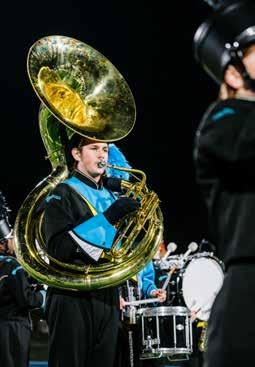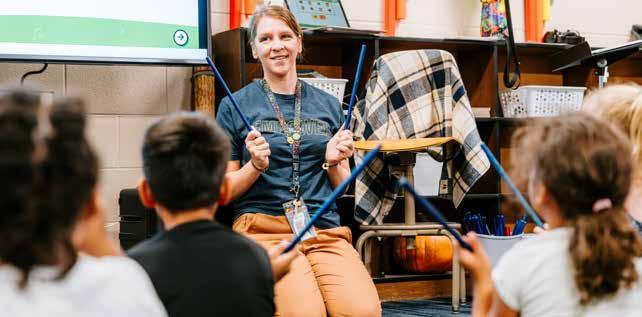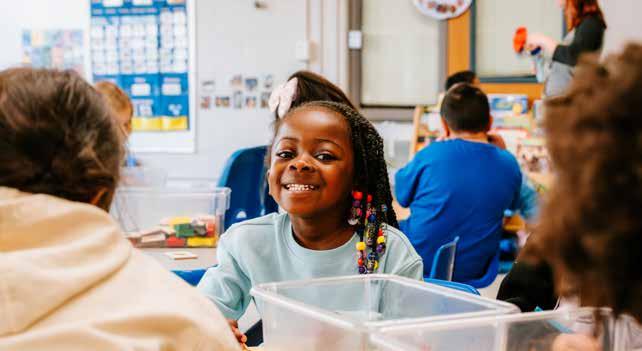
GREATNESS STARTS WITH A GOAL


GREATNESS STARTS WITH A GOAL







MISSION Grandview C-4 is a community, preparing students for life after high school with the skills needed to live a life through passion and purpose for the greater good of the communities they impact.




Challenging all learners to think critically and creatively.
Making learning more engaging, relevant, and meaningful in a technology-rich environment.
Developing collaborative leadership.
Promoting continuous improvement through data-driven decision-making.
Creating an educational environment where there are high expectations for learning and collaboration to develop high-quality skills.
Providing safe, clean, and healthy environments, with
The Curriculum and Instruction Department’s top priorities are to ensure students graduate with the academic knowledge and professional skills that make them #FUTUREREADY.
*(MSIP 6 Domains: Teaching and Learning (TL), Leadership (L), Alignment of Standards, Curriculum and Assessment (AS), and Data-Based Decision Making (DB)
Assistant Superintendent of Curriculum and Instruction
Director of Curriculum and Instruction
Director of Instructional Technology
Provide a comprehensive, rigorous, and inclusive educational program that is aligned with state standards and prepares our students to be future-ready.
Develop and revise curriculum for all grade levels and content areas.
Regularly audit district curriculum, assessments, and resources based on the district implementation plan.
Develop and implement a district-wide grading and assessment framework.
Review and revise curriculum in all grade levels and content areas as needed.
Audit district curriculum, assessments, and resources based on the district implementation plan.
Develop and implement a district-wide grading and assessment framework.
Embed Real World Learning (RWL), Technology, Problem-Based Learning (PBL), Market Value Asset opportunities, and Social Emotional Learning (SEL) skill-building for students within the written curriculum. 1 2 3 4
Embed Real World Learning (RWL), Technology, Problem-Based Learning (PBL), Market Value Asset opportunities, and Social Emotional Learning (SEL) skill-building for students within the written curriculum.
OBJECTIVE A
Create a learning environment where every student receives high-quality, evidence-based instruction in their classroom every day.
Identify, develop, and effectively communicate a district instructional framework.
Continue to develop the building instructional coaching model to provide support for Tier 1 instruction and Social Emotional Learning.
Develop, revise, and implement a Multi-Tiered System of Support (MTSS) Process.
Yearly review and revise the Student Support Team (SST) Process.
All schools will utilize the Professional Learning Community (PLC) structure and processes to improve student achievement.
Review the district instructional framework and then continue to communicate to all stakeholders.
Review the building coaching model to ensure it is providing support for Tier 1 instruction and Social Emotional Learning.
Review and revise the Multi-Tiered System of Support (MTSS), as needed.
Review and revise the Student Support Team (SST) Process, as needed.
Monitor the Professional Learning Community (PLC) structure and processes to improve student achievement.
Continue to utilize the Networked Improvement Community (NIC) process to improve student achievement.
7
8
Identify, develop, and effectively communicate a district-wide technology integration framework.
Create and provide high-quality, professional development based on internal feedback that aligns with district, building, and individual professional goals.
Continued implementation of the Networked Improvement Community (NIC) process to improve student achievement.
Develop, implement, and communicate a district-wide technology integration framework.
Create and provide high-quality, professional development based on internal feedback that aligns with district, building, and individual professional goals.


B
Student achievement data throughout the District will demonstrate growth as evidenced throughout the analysis of state and district achievement data and the Annual Performance Review (APR).
The district will increase the number of students graduating in a 4-year cohort with the goal of 90%. (Currently 73%)
The district will increase the percentage of students attending 85% of the time with a goal of 90% of students. (currently, 67.5% attend 85% of the time)
The District will increase the percentage of students scoring in the proficient and advanced category on the Missouri Assessment Program (MAP), End of Course (EOC) in ELA, Math, and Science each year with a goal of 80%.
The District will increase the percentage of students who score on or above grade level in iReady Reading and Math with the goal of 80%.
Increase the number of students graduating in a 4-year cohort with the goal of 90%.
Increase in the percentage of students attending 85% of the time with the goal of 90%.
Increase in the percentage of students scoring in the proficient and advanced category on the Missouri Assessment Program (MAP), End of Course (EOC) in ELA, Math, and Science each year with a goal of 80%.
Increase in the percentage of students who score on or above grade level in iReady Reading and Math with the goal of 80%.
OBJECTIVE A
The District will increase kindergarten readiness through quality early learning experiences that promote a child’s growth.
Develop a long-range plan to increase Pre-K enrollment that is consistent with the needs of the community.
Continue to revise and enhance Kindergarten programming throughout the District while maintaining a focus on early literacy.
Increase attendance to summer programming for incoming kindergarten students.
Develop and implement a long-range plan to increase Pre-K enrollment that is consistent with the needs of the community.
Review and revise Kindergarten programming throughout the District while maintaining a focus on early literacy.
Increase attendance to summer programming for incoming kindergarten students.
FOCUS AREA
A
Further expand real-world learning experiences for all students through the integration of Real-World Learning throughout all subject areas while expanding community partnerships, student skills development, and career exploration.
24-25 25-26 26-27
100% of high school students will select a Career Academy and Pathway of college or career interest to participate in while also being provided opportunities to explore multiple pathways.
Create and implement a yearly audit cycle for all Grandview High School (GHS) Academies and Pathways to ensure Market Value Asset (MVA) alignment.
100% of students will graduate with at least one Market Value Asset (MVA) by 2030.
100% of high school students have selected a Career Academy and Pathway of college or career interest to participate in while also being provided opportunities to explore multiple pathways.
Developed and implemented a yearly audit cycle for all GHS Academies and Pathways to ensure Market Value Asset (MVA) alignment.
100% of students will graduate with at least one Market Value Asset (MVA) by 2030.
Human Resource’s (HR) top priorities are to focus on the recruitment, development and retention of quality staff to ensure the best educational opportunities for #FUTUREREADY students.
*(MSIP 6 Domains: Teaching and Learning (TL) and Leadership (L))
GOAL #2
OBJECTIVE A OBJECTIVE A
Ensure the recruitment of quality staff, while adequately representing the students and the Grandview C-4 School District community at large.
Ensure the district’s workforce represents the students and community we serve through ongoing recruitment with higher education colleges/universities.
Expand relationships with postsecondary institutions to support the recruitment of quality teachers.
Provide semiannual information to paraprofessionals and volunteers on teaching certification programs offered by regional colleges and universities.
Develop incentives for hard to fill jobs, such as school bus drivers or critical shortage teaching positions.
Create internship opportunities for high school students within the district related to the teaching profession (Grow Your Own).
Provide recruitment in the areas of local higher education institutions and HBCUs, ensuring the focus of hiring multilingual staff annually as measured by the number of college visits, applicants and hires.
Share communication with paraprofessionals and volunteers regarding teaching opportunities as measured by email and in person coaching.
Analyze critical shortage or hard-to-fill workforce positions. Develop incentives to decrease the number of vacant openings.
Create and implement the Grow Your Own program for high school students by the 26-27 school year. Measure yearly benchmarks to measure adequate progress.
Implement a system that retains quality staff.
Implement onboarding maps for all workforce groups to ensure a comprehensive and structured introduction to the district.
Conduct annual perception surveys to assess the overall engagement of district staff (exit survey, climate and culture survey, district strengths survey, engagement survey and STAY PUT interviews with new staff).
Create a district level Human Resource committee to review data and make annual recommendations for retention improvements.
Provide leadership training on cultivating a culture of engagement with all workforce groups.
Create and implement onboarding maps for all classified workforce areas by the 26-27 school year measuring yearly benchmarks to measure adequate progress.
Conduct annual perception surveys to maintain (or increase) a 72% engagement percentage within the GVC4 school district.
Provide leadership training on cultivating a culture of engagement with all workforce groups as measured by Panorama perception data. 1
Create and convene a district level Human Resource committee to review data and make annual recommendations for retention improvements.

Implement a staff recognition program through the Human Resources department to acknowledge and reward outstanding contributions.
Utilize technology to develop innovative opportunities for district leaders to foster connections with workforce groups, enhancing communication and engagement.
Expand mentorship to include experienced educators when entering into the GVC4 school district during their first and second year of employment.
Increase choice of personal and professional development offerings for all staff to support their growth and increase satisfaction.
Enhance benefit offerings based on current staff needs to ensure they are relevant and competitive.
Create and implement a monthly employee recognition program for all workforce groups as measured by Panorama survey data.
Leaders will connect with all building or department staff at a minimum of once per month to increase positive rapport and building culture as measured by Libra data and Panorama survey data.
Work with the Curriculum and Instruction team to expand teacher mentorship for experienced teachers that enter the district within years 1 and 2 of employment by August of 2024. In addition, an annual survey will be conducted with experienced teachers (new to the district) to measure perceptions of mentorship support the first year of employment to improve/enhance mentorship experience as needed.
Professional development will more adequately meet staff needs as measured by Panorama surveys and staff feedback.
The workforce will be surveyed to identify needs in order to negotiate more customized packages with benefit providers with satisfaction measured through exit surveys, stay put interviews, and other feedback opportunities.
Implement
Develop a district profile of a quality leader to establish clear expectations and attributes of effective leadership.
The continuation of the Aspiring Principal Cohorts with embedded leadership shadowing and field experience for participants will be measured by retention of cohort graduates and/or movement into various leadership positions. 1 2 3
Through the use of survey data, leadership will develop a district profile of a quality leader to be used in guiding evaluations as measured by the dissemination and usability of the profile(s) by workforce evaluators.
Provide professional learning for leaders that is aligned with the district’s strategic plan to ensure continuous growth and alignment with district goals.
Continue to provide Aspiring Principal Cohorts to include embedded leadership shadowing and field experiences for participants.
Survey leaders to identify preferred areas of growth related to the current CSIP in order to create more customized professional learning plans.

Provide quality staff evaluations.
Develop a district profile of a quality teacher/employee.
Fully implement all components of the Network for Educator Effectiveness (NEE) Evaluation System.
OBJECTIVE D
Through the use of survey data, leadership will develop a district profile of a quality teacher/employee to be used in guiding evaluations as measured by the dissemination and usability of the profile(s) by workforce evaluators.
Through the use of annual benchmarks, the district will fully implement all components of the NEE by 2026-2027.
Provide quality professional learning to leaders in areas of evaluation, feedback and staff development.
Provide continuous professional learning for directors, principals, and staff on the implementation of the Network for Educator Effectiveness (NEE) Evaluation System.
Provide ongoing professional learning focused on the implementation of classified staff evaluations to ensure comprehensive assessment practices.
Create and implement staff development training programs that provide feedback, coaching techniques, and corrective actions that enhance leadership skills in supporting staff.
Through the use of annual benchmarks, district leaders will be trained in how to fully implement all components of the NEE by 2026-2027.
District leaders will utilize consistent comprehensive assessment practices to evaluate classified staff.
District leaders will be able to implement staff development training programs that enhance leadership skills in supporting staff as indicated by improvement in staff performance as measured by the NEE.
The priorities in the operational readiness are focused on the key operational areas of finance, facilities, safety/security, child nutrition, and technology while underscoring the district’s commitment to efficiency and excellence.
*MSIP 6 Domains: Leadership (L) and Data-Based Decision Making (DB)
Assistant Superintendent of Finance and Operations
Director of Finance
Monitor local, state and federal legislations and revenue trends. Identify the implications on the district’s long-term and short-term fiscal plan.
Conduct frequent financial reviews of current financial status through real-time monitoring as well as annual external audits of all financial, attendance, and transportation records to ensure effective financial management.
Implement prudent fiscal management practices that ensure the district’s financial stability through effective budgeting, regular financial monitoring, and cost-saving measures such as maximizing resources, minimizing unnecessary expenses, and ensuring that funds are allocated in a manner that best supports our educational objectives.
Develop an annual budget and longrange financial plan to align available resources with priorities to support the 2024-2027 strategic plan and maximizes the impact on student learning and supports our educational objectives.
Develop and implement a three-year financial plan that includes a budget to support staff salaries, district services, and district initiatives.
Create and present the Annual Secretary of the Board Report (ASBR) to the Board of Education and submit it to the Department of Elementary and Secondary Education (DESE).
Three year financial plan development and presentation to the Board of Education.
Utilize budget amendments as a process to ensure the annual budget is as accurate as possible during each school year.
Contract with audit firm to review all financial, attendance, and transportation records.
Meet with the District’s finance committee as a method to oversee all warrants, reimbursements, payroll, and purchasing.

A
The district will efficiently allocate bond proceeds towards enhancing facilities, implementing safety upgrades, and acquiring essential equipment to provide an optimal learning environment for our students.
Develop and implement a comprehensive, long-term facilities plan that anticipates future building needs, while continuously advancing our efforts in ensuring safety and security.
Continue to engage the District Safety Committee to proactively assess, monitor, and execute safety programs, ensuring a secure and safe environment throughout the school district.
Develop a comprehensive, long-term plan that prioritizes energy effciency across the district, with the dual objectives of maintaining seamless technology and communication services during power outages and realizing potential cost savings.
A
Deliver daily transportation services to students, prioritizing the enhancement of operational efficiency and the unwavering commitment to the safety of all students.
Refine and revise the annual replacement cycle plan while concurrently maintaining the existing fleet of school buses and vans in optimal condition.
Maintain the continuous learning program for all transportation staff, ensuring they undergo comprehensive bus safety training at least twice a year, and provide refresher courses as needed to keep safety procedures top of mind.
Continue to gather feedback stakeholders to ensure the highest quality of transportation services are being provided as well as identifying opportunities for improvement.
Revise and implement the vehicle replacement cycle plan. Participate in the Missouri Highway Patrol Inspections with a stated goal of achieving 90% or above.
Survey results from parents/guardians on transportation services.
Create a strategic communication plan aimed at enhancing stakeholder awareness and engagement in our child nutrition services, while also boosting the number of parents/guardians applying for Free/Reduced meals.
Increase and enhance student and parent/guardian participation in menu creation by forming dedicated focus groups at every educational level.
Leverage student surveys and feedback sessions to identify effective strategies for boosting participation in breakfast and lunch programs, such as implementing a second chance breakfast initiative.
Ensure that every student receives a nutritionally balanced breakfast and lunch, prepared in compliance with Federal and State nutrition program regulations, thereby supporting their health, well-being, and academic performance.
Develop and implement a transition plan with the Food Service Management Company (FSMC) to upgrade facilities and equipment to provide enhanced options for students.
Meet with the Food Service Management company to review feedback and areas of improvement based upon feedback.
Utilize the student information system to consistently monitor the submission of free/reduced lunch forms, with the objective of achieving a minimum of 5% annual increase in the number of forms collected.
Survey students on menu creation, as well as food quality, and identify areas of improvement.
Survey results from parents/ guardians on menu creation, as well as awareness of child nutrition services, and identify areas of improvement.

Fortify and maintain a robust and secure internet and network infrastructure, crucial for bolstering our district’s technology initiatives and ensuring a safe and protected digital learning environment.
Maintain a robust and secure network infrastructure with a commitment to regular upgrades and real-time monitoring for potential risks, ensuring optimal uptime, swift response to vulnerabilities, and timely implementation of necessary improvements.
Conduct security audits and implement any necessary network upgrades identified.
Utilize network data to review network uptime with a goal of 99%.
Ensure that every student and staff member has access to our technology resources and repair services, fostering a seamless digital learning environment that prepares our students to be future-ready.
Continue to support and sustain 1:1 technology access for all K-12 students and teachers, incorporating a regular replacement cycle to keep our computers, servers, network equipment, and software current and efficient.
Formulate and implement an ongoing comprehensive technology audit that assesses our current infrastructure, identifies areas for improvement, and ensures our technology resources align with our educational objectives.
Review the technology plan and ensure 100% of K-12 students and teachers have 1:1 technology access, with a regular replacement cycle implemented every 3-4 years, or as needed, to keep all technology resources current and efficient.
Technology audit results are used to determine areas of strength as well as areas of need throughout the District.

The top priorities in the area of climate and culture are focused on ensuring a sense of belonging for all district and community stakeholders.
*(MSIP 6 Domain: Collaborative Culture and Climate)
All stakeholder groups in Grandview C-4 will have a perceived sense of belonging and feel they are valued members within the school district community. The District will prioritize creating an environment that fosters intentional connections between internal and external stakeholders, enhancing staff involvement in initiatives and decisionmaking, and actively engaging parents, guardians, and community members. Strive to improve the sense of belonging for marginalized students and families by addressing potential barriers, formalizing student participation in decision-making, and promoting collaboration among staff, students, parents, and community members for a collective sense of ownership and belonging in the school community.


Determine the current sense of belonging rates for each stakeholder group through the implementation of annual surveys (students, staff, parents/guardians and partners/ community members).
Develop a comprehensive plan to increase community engagement overall and differentiate between stakeholder groups to identify any potential areas of need.
Provide key stakeholders with annual engagement surveys.
Develop a comprehensive plan to increase parental involvement at all levels possibly including hosting community forums, creating parent advisory groups, and providing restorative practices for all families.
Continue to enhance diversity and inclusion training opportunities for staff, administrators, board members and other identified community groups on topics such as cultural competence, implicit bias, and creating inclusive classrooms.
Annually review with the CSIP team the activities that involve the integration and inclusion of student, parent and partner/community voice/engagement.
Create and implement a district level parent advisory group that meets semi-annually beginning in the 24-25 school year.
Create and implement building level parent/student advisory groups that meet semi-annually beginning in the 24-25 school year to provide feedback on the creation of a comprehensive parental involvement plan.
Create diversity and inclusion statements and comprehensive training plan for the Grandview C-4 school district by May of 2025.
Fully integrate Social and Emotional Learning (SEL) within the Grandview C-4 School District with the objective of assessing current levels of equity throughout the district and empowering all stakeholders to co-create schools that excel in all areas that contribute to safe, healthy, and thriving school communities.
– Explore ways to promote SEL through explicit instruction, integration into academic learning, and a supportive learning environment.
– Set clear, measurable goals for promoting SEL for students, using the District’s and individual school’s shared vision, needs and resources, assessment as a reference.
– Explore ways adults can learn and reflect on their own social and emotional competencies while collaborating with one another to support and model SEL.
Survey staff and students in the 2024-2025 school year, and then annually, to determine the current levels of social and emotional strengths and opportunities for growth.
Use data from the staff and student survey to develop annual goals to reinforce the ongoing social and emotional wellness of all students and staff within the district.
Use data from stakeholder surveys to determine next steps in implementation of SEL curriculum throughout all classrooms in the District.
Panorama surveys will be used to obtain baseline data and compare percentages to nationally normed data.
Monitor annual Panorama survey data based on trends and themes to prioritize wellness programming, social and emotional curriculum priorities.
SEL curriculum for Tier I instruction will be created and implemented in the 25-26, 26-27 and 27-28 school years.
PHYSICAL, SOCIAL, COMMUNITY & CAREER WELLBEING)

Foster and enhance a positive culture through the ongoing development and integration of the District’s Employee Wellness Program. The employee Wellness Program will provide quality essentials in the areas of financial, physical, social, community & career well being.

Develop wellness essentials for programming that includes a wellness framework and a communication for delivering the wellness framework to district employees.
Survey staff annually to assess programming outcomes and identify current levels of interest within the five essentials.
Use survey data to develop annual goals to enhance wellness programming based on needs and interests of employees.
Develop wellness essentials for programming that includes a Wellness Framework by August 2024.
Complete a communication plan by January 2025 to provide employees with information on the Wellness Framework.
Develop and implement wellness programming to address the following wellness programming gaps:
– A districtwide nutritional policy for employee health and wellbeing (healthy vending, healthy snacks and nutritional planning) by May 2025.
– A districtwide active living goal for employees to promote movement both in and outside of the employee’s workplace by May 2025.
– A short and long-term substance abuse program to increase employee accessibility to treatment by May 2025.
Administer perception surveys to key stakeholders to determine interests within the five essentials of wellness in order to prioritize wellness offerings fr om year to year.
Use perception surveys to annually review and revise wellness programming goals as appropriate.
